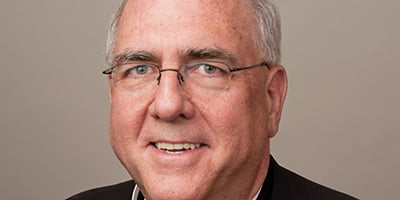by Archbishop Joseph F. Naumann
I am still in the Holy Land with other pilgrims of the Equestrian Order of the Knights and Ladies of the Holy Sepulcher.
Last week, I wrote that the mission of the Holy Sepulcher — preserving and keeping open the access for Christians of the shrines in the Holy Land — is important because we believe in the historical Jesus. In other words, Jesus was a real person who actually walked this earth, giving special significance to the places where the important events of his life occurred.
However, we do not just believe in the historical Jesus. We do not believe that Jesus was simply like other great historical figures — Alexander the Great, Julius or Augustus Caesar, Charlemagne, Na- poleon, George Washington or Abraham Lincoln — whose memories we remember and, in some cases, revere.
Many years ago, I read a book about Jesus by Malcolm Muggeridge. Muggeridge was a very well known and popular British Broadcasting Company (BBC) personality. Many American Catholics first became acquainted with Muggeridge through his television documentary that subsequently became a book, “Something Beautiful for God.” It was Muggeridge’s book that catapulted Mother Teresa of Calcutta onto the international scene and made her an icon of what is best in humanity.
At the time he met Mother Teresa, Muggeridge was a self-declared agnostic who had been assigned the task of producing and narrating a documentary about a nun in Calcutta who had evidently caught someone in the BBC’s attention for her work with the poor. He was totally captivated by Mother Teresa. After his documentary about Mother Teresa, Muggeridge became a believer in Jesus. Many years later, largely because of her influence, Muggeridge would become a Catholic.
At some point during this conversion process, the BBC asked Muggeridge to do a several part documentary on the life of Jesus. Muggeridge quite naturally took his crew to the Holy Land to film the sites where Jesus lived.
Logically, he decided to begin shooting in Bethlehem, where Muggeridge describes experiencing what he termed an “illumination” at the Church of the Nativity. They began filming in the fields outside of Bethlehem where they encountered a shepherd with a sheep draped over his shoulder — very much like you might see featured on many Christmas cards. The crew prepared to begin shooting when the shepherd threw down the sheep to haggle over his fee.
After settling what he called this “unseemly transaction,” Muggeridge and his entourage proceeded to the Church of the Nativity. He described the difficulty of getting into the church because of the press of those hawking postcards, rosaries and other souvenirs.
Once inside, Muggeridge positioned himself on a ledge in the crypt that commemorates the actual location revered as the place of Jesus’ birth. Muggeridge sat in the shadows cast by the candles which provided the only illumination in the area. He was not impressed by the way the crypt was adorned. He described it as tawdry and garish. Muggeridge then noticed the people in the church whom he described as “standard pursuers of happiness for whom the Church of the Nativity was just an item on a sightseeing tour.” He was disillusioned by all that he saw.
Then, Muggeridge began to notice the faces of the people that seemed somehow transfigured as they reflected on what happened at that very place. He observed how despite the rather chaotic surroundings, so many of the people began to be absorbed in what appeared to be very intense and sincere prayer. He realized they were not just visiting a historic place and recalling what had happened, they were actually entering into communion with the One born there.
It was from this experience that Muggeridge entitled his documentary and subsequent book, “Jesus: The Man Who Lives.” He realized that Jesus was not just a historical person to be studied, but was very much alive and animating the lives of his disciples (like Mother Teresa) some 2,000 years later.
This historical Jesus continues to live today. You are reading this column because you have met this Jesus. You have encountered him in the Eucharist and the sacraments. You have communicated with Jesus through prayer. Jesus did not just come into the world at one moment of history and vanished. No, Jesus rose from the dead as testified to by the transformation of the apostles. He is risen! He is alive! He offers us friendship. He shares with us his life — everlasting life.
It is this Jesus, the man who lives who animated the Crusaders 1,000 years ago and who animates millions of people today to live according to his Gospel.


